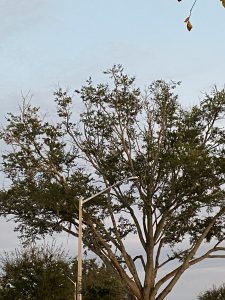The crown of a tree is the leaf bearing twigs and branches and the spreading green foliage that we see. A heathy, full crown is a good indication of a healthy and vibrant tree. The crown and the foliage it supports is the energy collector and the center for photosynthesis, which is how the tree produces the energy it needs to live. For a tree to live and thrive, a full crown of leaves is essential, and an unhealthy and thin crown is an indicator the tree has issues. Crown dieback is often not noticed until it is relatively severe and at that point it can be too late. If a tree drops below a certain percentage of live crown it can no longer support itself and continues to decline. The good news is that if you notice your tree is starting to show signs of crown thinning and dieback you can likely intervene to improve its health or diagnose a problem early.

Tree Showing crown dieback, note the dead branches and lack of foliage on the outer branch tips.
Photo Credit-Ian Stone
Crown dieback, which is also referred to as crown decline, is a progressive issue that starts small and can progress to the point that only small sparse areas of foliage are left. It is a tree’s response to various stressors, including environmental conditions and severe rot/decay. As a response to severe stress, the tree begins to abort part of the leaves and some of the small branch tips. If the stress continues to worsen, the tree will continue to abort more of the crown, producing progressively more dead wood. The tree is essentially trying to prune itself back to a manageable level of foliage based on the stress it is encountering. This can occur in both small, young trees and mature, established trees. A variety of conditions cause the stress that begins this process. For instance, you may notice crown dieback in young trees planted in compacted urban conditions such as parking lots and paved areas. Trees in these conditions experience stress from the compacted soil and encounter subsequent issues with water and nutrient stress. Large mature trees in an area that experienced recent construction may also exhibit dieback, especially if buffers and setbacks are not maintained or significant fill dirt is brought in. Issues from root disturbance and compaction cause stress and root dieback, which in turn causes visible crown dieback. Additionally, trees that are experiencing rot, decay, and other vascular disease issues will often begin to exhibit dieback. As the rot or vascular disease progresses, the tree is less able to transport water to the crown, which results in the crown dieback that can be seen as the crown thins. Often, in cases of rot, crown dieback will be the primary visible symptom that rot is occurring, as the rot can be concealed deep in the tree. While multiple stressors can be the cause of crown dieback, it is a clear indicator a tree is stressed and in trouble. If this condition goes unnoticed, it can progress past the point that the tree can be saved. However, if noticed and caught early, good tree care techniques can be applied that may restore the tree to heath. In cases of severe rot and decay, having the tree examined may prevent structural failure of a tree exhibiting crown dieback.
If you have a tree on your property that is exhibiting crown dieback, it is a good idea to have the tree examined by a professional to determine the extent and nature of the issue. Key signs of dieback are bare branch tips and dying foliage during spring and summer. It is natural to have some dead wood in a tree, but extensive dead wood around the entire perimeter of the crown is a cause of concern. With good diagnosis, the proper tree care techniques can be applied to help a tree recover. Waiting and hoping a tree with crown dieback will recover on its own is not a good course of action. Recognizing crown dieback and taking early action is the key to success. Contacting a Certified Arborist (www.treesaregood.org ) is a good step in getting an opinion on the extent of dieback, if the tree is recoverable, and how to best address the issue. You can also contact your local County Extension Office or Florida Forest Service County Forester for assistance.
- Pro-Tips for Dealing with Problem Oaks and Other Brush in the Home Landscape - November 21, 2024
- Elderberry: A Very Attractive and Useful Native Plant - June 20, 2024
- Pine Bark Beetles – With Warming Weather Comes More Activity - May 9, 2024
